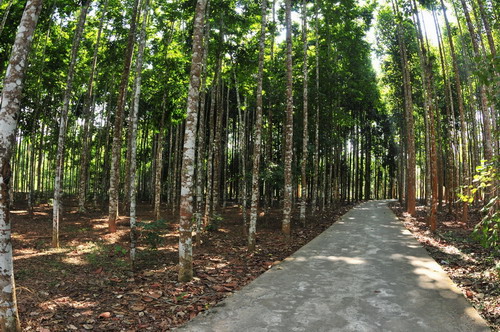Resorption is a process by which nutrients are translocated from the senescing leaves to the storage organs or growing tissues. Nutrient resorption plays a pivotal role in the nutrient economy of plants and ecosystems. However, few studies have looked at the actual mechanisms of nutrient resorption, and what other leaf traits could be involved in this process. Which plant traits mediate nutrient resorption? How is resorption efficiency associated with other leaf traits? Does nutrient resorption have an impact on plant growth performance?
To answer these questions, Dr. ZHANG Jiaolin and his colleagues of Xishuangbanna Tropical Botanical Garden (XTBG) conducted a common garden experiment in Dipterocarp Collection of XTBG. They compared the nutrient resorption of 17 dipterocarp tree species grown for more than 12 years on nutrient poor tropical soils. They regressed the nitrogen (N) and phosphorus ( P) resorption efficiencies against a suite of traits associated with leaf vein density (i.e. total vein length per area) , the leaf economics spectrum (e.g. leaf mass per area) and species growth performance (i.e. height- and diameter growth rates).
They hypothesized that nutrient resorption would be positively related to the phloem transport capacity, as indicated by leaf vein density. They found a strong positive association of N resorption efficiency (percentage N resorbed ) and a negative association of N resorption proficiency (N remaining in senesced leaves) with leaf vein density. They also found that N resorption proficiency was associated with leaf thickness.
Their second hypothesis was that nutrient resorption efficiency was positively associated with growth rate. They found nitrogen efficiency was significantly and positively correlated with height and diameter growth rates across dipterocarp species.
They further hypothesized that more P would be resorbed than N. In their common garden experiment,P resorption efficiency was indeed higher than N resorption. P resorption efficiency and proficiency were not related to any of the leaf morphological and anatomical traits, such as leaf vein density, leaf mass area, and leaf thickness. They also found that P resorption efficiency and proficiency were not related to tree growth either.
The study provides evidence that N resorption of the dipterocarp species is linked to leaf vein density, and that it is closely associated with leaf nutrient conservation traits such as leaf mass per area and leaf thickness. There are significant correlations between growth rates and green leaf N concentration. Marginally significant correlation existed between N resorption and diameter growth rate. These results suggest that growth rates of the dipterocarps are more likely governed by photosynthetic rates associated with green leaf N concentration than N resorption rates . Although P is generally deficient in tropical soils, it appears that N rather than P availability is the key limiting factor for the growth of the dipterocarp species.
The study entitled “Nutrient resorption is associated with leaf vein density and growth performance of dipterocarp tree species” has been published online in Journal of Ecology.

Dipterocarp Collection of XTBG (Image by DUAN Qiwu)

Dipterocarp trees (Image by Duan Qiwu)


